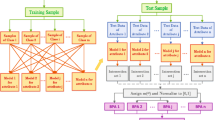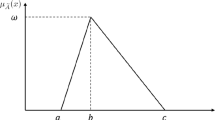Abstract
Dempster-Shafer (DS) theory of evidence has been widely used in many data fusion application systems. However, how to determine basic probability assignment, which is the main and the first step in evidence theory, is still an open issue. In this paper, a new method to obtain Basic Probability Assignment (BPA) is proposed based on the similarity measure between generalized fuzzy numbers. In the proposed method, species model can be constructed by determination of the min, average and max value to construct a fuzzy number. Then, a new Radius Of Gravity (ROG) method to determine the similarity measure between generalized fuzzy numbers is used to calculate the BPA functions of each instance. Finally, the efficiency of the proposed method is illustrated by the classification of Iris data.
Similar content being viewed by others
References
D. L. Hall. Mathematical Techniques in Multisensor Data Fusion. MA, Artech House, 1992, 14–36.
A. Dempster. Upper and lower probabilities induced by multivalued mapping. Annual Mathmatics Statistics, 38(1967)6, 325–339.
G. Shafer. A Mathematical Theory of Evidence. NJ, Princeton University Press, 1976, 78–103.
S. Le Hegarat-Mascle, I. Bloch, and D. Vidal-Madjar. Application of DS evidence theory to unsupervised classification in multiple remote sensing. IEEE Transactions on Geosciences and Remote Sensing, 35(1997)11, 1018–1031.
R. R. Yager. A class of fuzzy measures generated from a Dempster-Shafer belief structure. International Journal of Intelligent Systems, 14(1999)12, 1239–1247.
Y. M. Zhu, et al. Automatic determination of mass functions in DS theory using FCM and spatial neighbourhood information for image segmentation. Optical Engineering, 41(2002)6, 760–770.
I. Bloch. Some aspect of DS evidence theory for classification of multimodality medical images taking partial volume effect into account. Pattern Recognition, 17(1996)9, 905–916.
F. Salzenstein and A. O. Boudraa. Unsupervised multisensor data fusion approach. IEEE Proceedings of ISSPA, KualaLumpur, Malaysia, August 9–12, 2001, 152–155.
A. Bendjebbour, Y. Delignon, L. Fouque, V. Samson, and W. Pieczynski. Multisensor image segmentation using DS fusion in Markov fields context. IEEE Transactions on Geosciences and Remote Sensing, 39(2001) 12,1789–1798.
Y. Deng, Z. F. Zhu, and S. Zhong. Fuzzy information fusion based on evidence theory and its application in target recognition. Acta Aeronautica et Astronautica Sinica, 26(2005)6, 754–758 (in Chinese). 뗋폂, 훬헱뢣, 훓즽. 믹폚횤뻝샭싛뗄쒣뫽탅쾢죚뫏벰웤퓚쒿뇪쪶뇰훐뗄펦폃. 몽뿕톧놨, 26(2005)6, 754–758
S. J. Chen and S. M. Chen. Fuzzy risk analysis based on similarity measures of generalized fuzzy numbers. IEEE Transactions on Fuzzy Systems, 11(2003)1, 45–56.
Y. Deng, et al. A new similarity measure of generalized fuzzy numbers and its application to pattern recognition. Pattern Recognition Letters, 25(2004)8, 875–883.
R. C. Hibbeler. Mechanics of Materials. New Jersey, Prentice Hall, 2000, 166–178.
R. Fisher. The use of multiple measurements in taxonomic problems. Annals of Eugenics, 7(1967)3, 179–188.
Author information
Authors and Affiliations
Corresponding author
Additional information
Supported by National High Technology Project (863)(No. 2006AA02Z320), the National Natural Science Foundation of China (No.30700154, No.60874105), Zhejiang Natural Science Foundation (No.Y107458, RY1080422), the School Youth Found of Shanghai Jiaotong University.
Communication author: Deng Yong, born in 1975, male, Ph.D. School of Electronics and Information Technology, Shanghai Jiaotong University, Shanghai 200240, China.
About this article
Cite this article
Deng, Y., Jiang, W., Xu, X. et al. Determinging BPA under uncertainty environments and its application in data fusion. J. Electron.(China) 26, 13–17 (2009). https://doi.org/10.1007/s11767-008-0121-9
Received:
Revised:
Published:
Issue Date:
DOI: https://doi.org/10.1007/s11767-008-0121-9
Key words
- Data fusion
- Dempster-Shafer (DS) theory of evidence
- Basic Probability Assignment (BPA)
- Generalized fuzzy number
- Similarity measure




